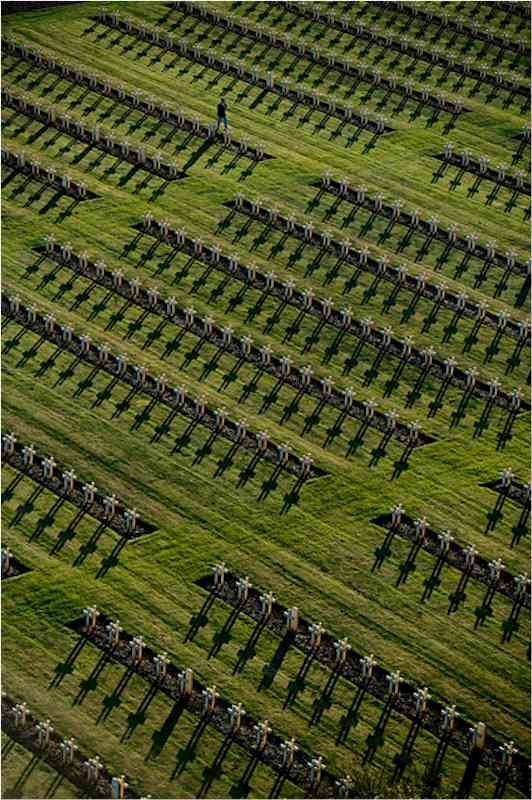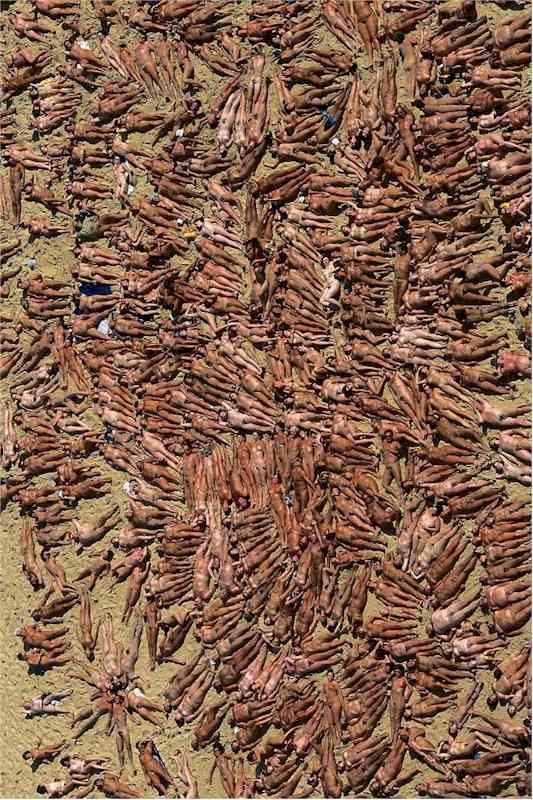Row upon Row
American Cemetery Near VerdunThe bitterest tears shed over graves are for words left unsaid and deeds left undone. - Harriet Beecher Stowe
American cemetery north of Verdun, Meuse, France (N 49°09'-E 5°23') Covering some 40 hectares (100 acres) at Romagne-sous-Montfaucon, 40 kilometers (25 miles) from Verdun, the American cemetery was dedicated in 1935 by the American Battle Monuments Commission. The commission was created in 1923 at the request of General Pershing, who had taken part in the American offensive of 1918. Its aim was to undertake architectural and landscape studies in order to restructure American cemeteries and commemorative monuments in Europe. Whereas the French army chose to build permanent cemeteries where temporary cemeteries had been made during the hostilities, the American army opted to create a single cemetery. Some 25,000 American tombs scattered around Verdun were then brought together at Romagne where, after almost half the bodies were repatriated to American soil, 14,246 soldiers have lain ever since. The butchery of the Great War so shocked the United States that it built numerous pacifist commemorative monuments at Verdun and in the Somme. For similar reasons, Verdun hosted an occasion of Franco-German reconciliation in 1984, and the town has been named the Capital of Peace, Freedom, and Human Rights. Source: yannarthusbertrand.com from Earth from Above, by the incomparable photographer Yann Arthus-Bertrand
Military Cemetery in FranceWhile seeking revenge, dig two graves - one for yourself. - Doug Horton
National Military Cemetery of Notre Dame de Lorette, near Ablain-Saint-Nazaire, Pas-de-Calais, France (50°23' N, 02°42' E) Two major conflicts devastated Europe before the words of Victor Hugo (1802 - 1885) became a prophecy: "No more armies, no more frontiers, a single Continental currency... The day will come when you will lay down your arms." Before unifying in peace, Europe had to go through two world wars; WWI cost 8 million lives, and WWII cost 45 million. The Battle of Lorette, from October 1914 to October 1915, in which the French and Germans struggled for possession of the strategic plateau of Artois, shed the blood of more than 100,000 victims on the fields of northern France. This military cemetery commemorates the fallen: 20,000 crosses are aligned across 30 acres, and eight ossuaries hold more than 22,000 unknown soldiers. Hugo also said, "The day will come when the only battlefields will be markets open to commerce and minds open to ideas." That day has come, but it is a battle whose outcome remains uncertain. Source: yannarthusbertrand.com from Earth from Above, by the incomparable photographer Yann Arthus-Bertrand
A Different Way of Getting Back to Nature
Naturistes du centre d’Arnaoutchot, Landes,France (N 43°55’-O 1°22’) On a beach near the coast of Vielle-Saint-Girons is one of the greatest naturist centers of France. The photographer gathered a thousand people for this shot. Cradle of the naturist movement since 1930, France accommodates 2 million naturist tourists annually, from all social strata, 60 % of whom are from its European neighbours. The naturists claim a desire "to be in harmony with nature." The numbers of people visiting this beach is dropping, as the population from which the visitors is drawn is ageing. France has 8,000 centenarians; in 50 years, it is estimated there will be 150,000. At the end of 21st century, people more than 60 years old could represent 30% of the world population (compared to 10% in 1995). In all countries, this change will have severe repercussions. Source: yannarthusbertrand.com from Earth from Above, by the incomparable photographer Yann Arthus-Bertrand
For articles related to ageing, including feats that can be accomplished, and a non-spiritual look at what happens after death - funerals, jerky, popsicles, fertiliser, ashes, orbit or dust - click the
"Up" button below to take you to the Index page for this Older and Under section. |
 Animals
Animals Animation
Animation Art of Playing Cards
Art of Playing Cards Drugs
Drugs Education
Education Environment
Environment Flying
Flying History
History Humour
Humour Immigration
Immigration Info/Tech
Info/Tech Intellectual/Entertaining
Intellectual/Entertaining Lifestyles
Lifestyles Men
Men Money/Politics/Law
Money/Politics/Law New Jersey
New Jersey Odds and Oddities
Odds and Oddities Older & Under
Older & Under Photography
Photography Prisons
Prisons Relationships
Relationships Science
Science Social/Cultural
Social/Cultural Terrorism
Terrorism Wellington
Wellington Working
Working Zero Return Investment
Zero Return Investment

